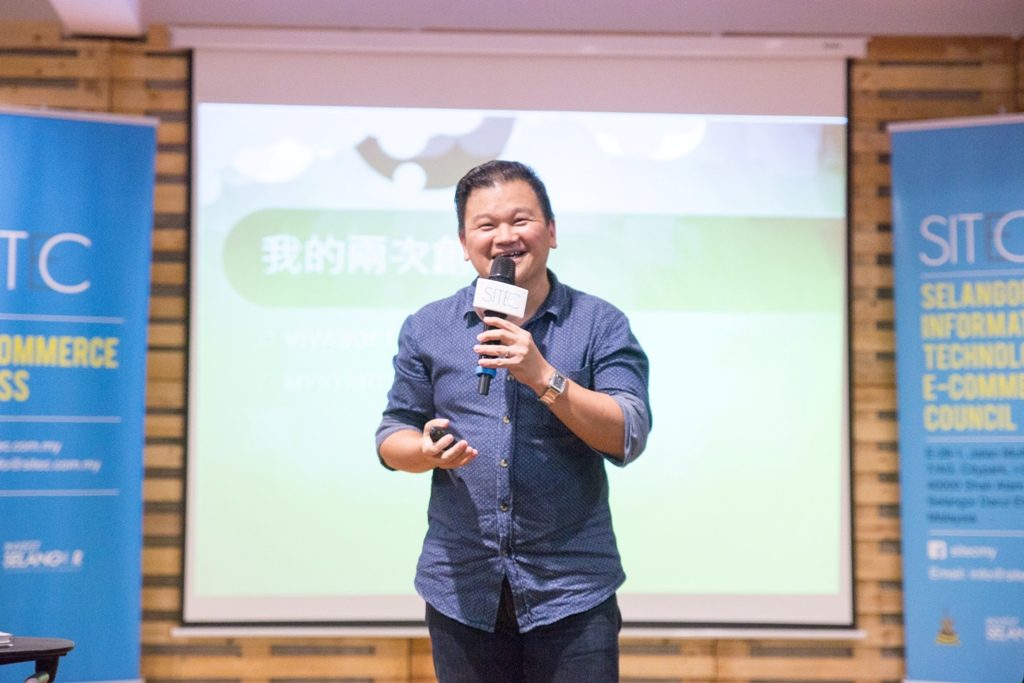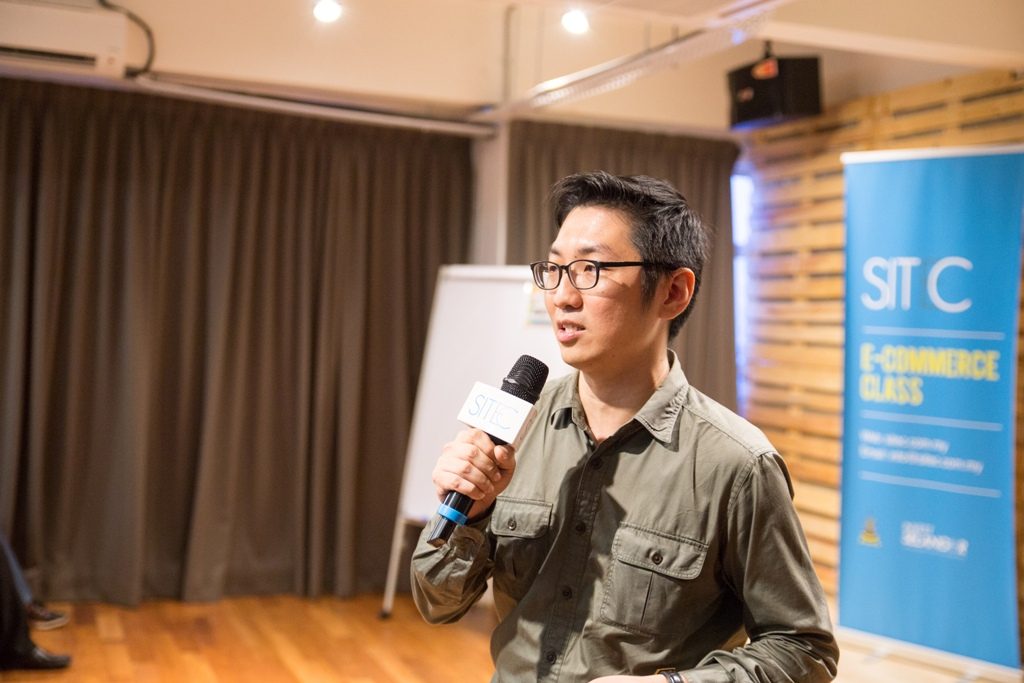First Chinese EC Class of 2016: On Entrepreneurship and Commerce
127 participants turned up for the very first Chinese language E-Commerce Class organised by the Selangor Information Technology and E-Commerce Council (SITEC) for the year 2016. The session, on the topic of Marketplace & Entrepreneurship, saw two speakers share about their stories of entrepreneurship and the analysis of the local e-commerce market, namely, Goh Boon Peng, CEO of Mystartr,and Stanley Lim, CEO of SiteGiant.
“A lot of people think that entrepreneurship revolves around mere selling and buying. That’s not true. Indeed it takes the combination of innovation and the spirit of entrepreneurship during the process of starting a new business”, said Goh, who started the session with a moving piece on how entrepreneurship is not the same as merely opening a wantan mee stall.
“If a person resigns and starts a new wantan mee stall, he is only moving the company output value to the noodle stall without transforming the resource and manpower from a lower output value to higher output value. Thus, this is not considered as entrepreneurship. But when the entrepreneur starts figuring the 2nd, 3rd stalls and comes up with new innovative methods, then this is the beginning of entrepreneurship.”, he added.

According to Goh (pictured, above), over the past few years, local startups have been receiving up to USD 300 million in funding as they appear to be scalable.
In a traditional industry such as the wantan mee stall as an example, the cost for setting up the first and second stall is not much different, yet they about the same amount of customers. However, for the IT industry, a small increase in the cost will be able to serve a much larger group of people.
Although the global focus is now on the SEA internet market, Goh added that this phenomenon will, at most, last 5-6 years, then it will shift to India. In fact, there are already companies entering the market, hence Goh advises these companies to speed up the progress and extend the model within these 2-3 years.
As the founder of Mystartr, a crowdfunding company, Goh spoke about the global development of the crowdfunding industry and mentioned that most of the platforms are product oriented, making it sort of like e-commerce businesses. Crowdfunding has to rely on a matured e-commerce environment in order to grow progressively.
Goh shared about his 2nd entrepreneurship journey where Mystartr was running out of investment funding within a year, and he struggled for a bit before he managed to successfully fund RM 290,000 from 29 people through the platform itself.
Goh also shared a comprehensive look into the history of e-commerce in Malaysia and the world.
In 2015, Malaysia was the first ASEAN country to introduce a regulatory framework to facilitate equity crowdfunding with six registered equity crowdfunding (ECF) platform operators to fully operationalise by 2016.
E-Commerce started approximately around 21 years ago, in 1995, with the birth of Amazon. Since the dotcom bubble in the 90s, Malaysia followed suit, with the formation of Lelong in 1998, but it wasn’t quite a breakthrough in e-commerce development.
It wasn’t until 2001 when Airasia was founded and started revolutionising and revitalising the e-commerce industry. Their famous tagline, “Everyone Can Fly”, as well as the increased affordability of air tickets boosted them to immense popularity, and online purchasing habits took flight as consumers started purchasing things online again.
Initially, AirAsia did not have the online booking feature, and 80% of the orders were through phone calls. To solve the phone congestion problem, Airasia appealed everyone to buy online and provided discounts as incentives for online purchases.
From there on, consumers got used to purchasing airtickets online, although it did not quite scale to other online purchases due to lack of confidence in online payment.
Enter Groupon in 2011 – revolutionising the EC scene once more
Groupon entered the scene with an O2O model – Online to Offline – by partnering with local merchants. Customers can buy coupons online, and use them offline, at retailers or F&B outlets, or even to purchase items from stores.
In 2012, the e-Commerce marketplace trend took off, with the founding of Lazada, Rakuten and Zalora, who worked with online sellers and deep pockets to fund aggressive marketing campaigns.
In 2015, Chinese-centric marketplace Logon.my catering to the needs of the Chinese community was founded by MCIL Multimedia (Sinchew), and in the same way, Korean marketplace 11street entered the scene, all of which boosted interest in e-Commerce again.
On Mobile-friendliness
Malaysia has about 20 million online users, and there is a clear preference for accessing content online via mobile devices such as phones and tablets, and this preference is important to businesses so that they ensure their products and services are mobile-friendly in order to capture a bigger market.
Another trend is the comparative nature of online purchases – customers naturally want to get the best bang for buck, and will browse extensively on various sites to ensure they get the best deal. However, it gets a little more complicated because consumers now also will compare online prices to offline prices – and as predicted, they will always choose the lowest prices first, even if it means they have to obtain it offline.

Next speaker was Stanley Lim from SiteGiant (pictured, above), who spoke about how entrepreneurs he’s seen are usually people who have been dissatisfied with the companies they have worked with as an employee and who feel they can do better by solving the issues present.
He himself started on his entrepreneurial journey with the idea of freedom in his mind, but soon realised it was anything but free. In his time spent running YinnPixel, the line between work and personal life was blurred, as he worked anytime, anywhere, sometimes even designing up to 20 banners in a day, and advised would-be entrepreneurs to never give up, especially at the beginning of their entrepreneurship.
He also shared that every entrepreneur will eventually come across the problem of insufficient resources, and this has to be tackled by innovation and perseverance. According to Stanley, if the entrepreneur blames his failure due to this reason, he is not likely to be suitable as an entrepreneur, as problems will always arise, and solutions have to get more innovative and workable.
Stanley also shared his “10 questions before stepping into e-commerce”. According to him, the main way to overcome insufficient resources is to “ask the right questions”. By understanding the problem, only then you can solve the issues.
These are the 10 questions to ask yourself before you decide to sell online:
- Why should customers buy from me?
- Where will my customers be coming from?
- Which marketing campaign can net me my biggest source of income?
- Will I get my income from new customers or existing customers and why?
- What are the biggest complaints from my customers?
- Who is my biggest competitor?
- What is the biggest blind spot of my competitor? What are the opportunities to me?
- What are my customer acquisition costs like?
- What is my biggest advantage from the perspective of my competitor?
- What is my current biggest challenge?
Facing the increasing number of online sellers, you have to develop your own unit selling point (USP), otherwise consumers won’t be seeing you at all. Here are the common forms of USP, which are not necessary to realise all:
- Multiple choice
- Big promotion
- Unique after-sales service
- Convenience (venue, on-time delivery)
- Premium products
- Super service
- More comprehensive and longer warranty
To check your own USP, you need to master the following 4 essential points:
- Clear and explicit descriptions that can be explained in one sentence. People want quick answers, not essays.
- Combine your marketing, sales, advertisement, online store, channels.
- Commitments are a must to be fulfilled
- List out your favorite shopping products or companies. What are the main reasons you support these companies?
The session ended with a short quiz and the handing out of prizes to the top winners.
